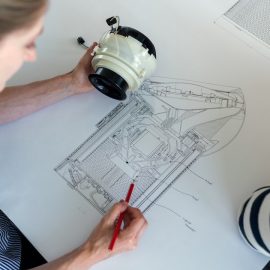

This article is an excerpt from the Shortform book guide to "Grit" by Angela Duckworth. Shortform has the world's best summaries and analyses of books you should be reading.
Like this article? Sign up for a free trial here .
Do you want to find purpose at work? How can finding meaning in the job you do help you to stay motivated and happy?
Oftentimes, people find themselves working jobs that don’t excite them. They work day in and day out and get frustrated if they don’t move up the career ladder. However, leaving the job may not be the answer—they are just missing purpose.
Here are three techniques for finding purpose at work.
Finding Purpose in Your Current Work
In Grit, Duckworth discusses three techniques that can help you find purpose at work:
1. Reflect on how the work you’re doing can positively contribute to society.
Researchers asked students to connect what they were learning with how the world could be a better place. The one-time intervention took just one class period. Compared to a control group, students increased their GPA (from 1.9 to 2.1), doubled their time studying on practice questions, and completed more math questions.
2. Think about how you can change your current work to connect to your core values, even if just in small ways.
The idea is that even if you don’t think of your job as particularly “purposeful,” you can still adjust your work practices to align with your interests and values. Duckworth discusses studies that show employees working in positions like sales and finance, who didn’t think of their positions as very purposeful, but were significantly happier and more motivated weeks after being asked to come up with ideas for changing their daily routines to make their work more meaningful.
3. Find a purposeful role model.
Identify someone who inspires you to be a better person, and who acts on behalf of other people. This exemplar proves to you that it’s possible to be successful carrying a mission greater than yourself. In turn, this inspires your own belief that you can personally make a difference.
| Purpose Leads to Motivation Daniel Pink explores how purpose affects motivation in his book Drive, noting that overall, motivation comes from either extrinsic forces (like a desire for money or status) or intrinsic forces (like a desire for mastery or a purpose). He argues that people are naturally motivated by intrinsic desires (think of the way a child naturally tries to learn to walk), but that we are taught to value extrinsic desires through societal expectations, our schooling system, and our employment system. He argues that people who are motivated primarily by intrinsic desires outperform those who are primarily motivated by extrinsic desires. They also have overall better mental and physical health. He notes that this doesn’t mean that intrinsically motivated people don’t also value things like money and status, but instead that they value things like responsibility and purpose more. To improve your motivation, or to increase the motivation in your workplace, Pink advises you look outward and try to see how your work benefits others. Like Duckworth, he observes that people are wired to help others, and that they find purpose in doing so. He, therefore, advises you to find the “why” behind your work (like Duckworth’s first recommendation above, to reflect on how your work contributes to society), and to see your work as a reflection of your values like honor, justice, or beauty (just as Duckworth asks you, in her second recommendation, to connect your work to your values). Pink doesn’t directly discuss Duckworth’s third point above, about finding a mentor or role model. Instead, he offers slightly different advice—advice that applies particularly to raising children. He recommends that to help your kids develop purpose and motivation, you give them variations of adult responsibilities. This will foster a sense of ownership of their tasks and will encourage them to feel intrinsically motivated to work on them. For example, you can have them work on a project of their choosing and have them set performance goals toward it. You can even give them performance reviews with specific feedback for improvement (as well as praise for things done well). This is essentially a reimagining of Duckworth’s role model idea—instead of advising you to find a role model for your kids, Pink advises encouraging children to become their own role model by modeling adult behavior. |
Exercise: Identify Your Purpose
Purpose corresponds to the “high-level goals” Duckworth discusses in her exploration of passion in the first part of the book. These are the goals at the very top, for which you can’t provide an answer to the question “Why?”
- Think of an everyday, lower-level goal that you have set for yourself. This might be one that improves a daily action (like getting up earlier every morning) or one that addresses a pattern of thought (like responding to criticism less defensively).
- Ask yourself “why” you aim for that goal. What larger goal does your everyday goal support?
- Now ask yourself “why” you aim for that larger goal. What even higher goal does it support?
- Continue asking “why” for each progressive goal, until you arrive at a question you can’t give an answer for. This will be your “because I do” question—your purpose. What is that purpose?

———End of Preview———
Like what you just read? Read the rest of the world's best book summary and analysis of Angela Duckworth's "Grit" at Shortform .
Here's what you'll find in our full Grit summary :
- How your grit can predict your success
- The 4 components that make up grit
- Why focusing on talent means you overlook true potential






